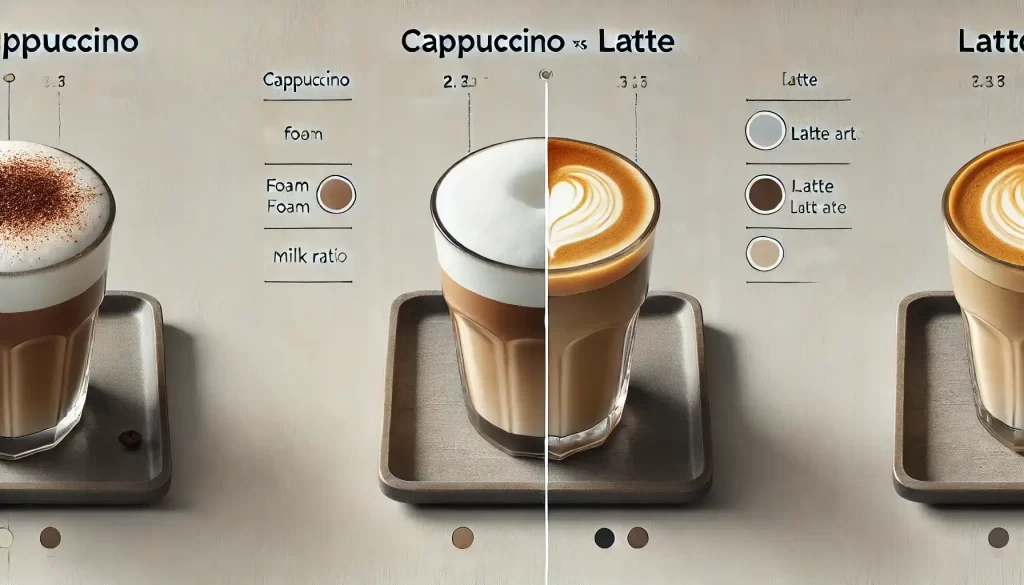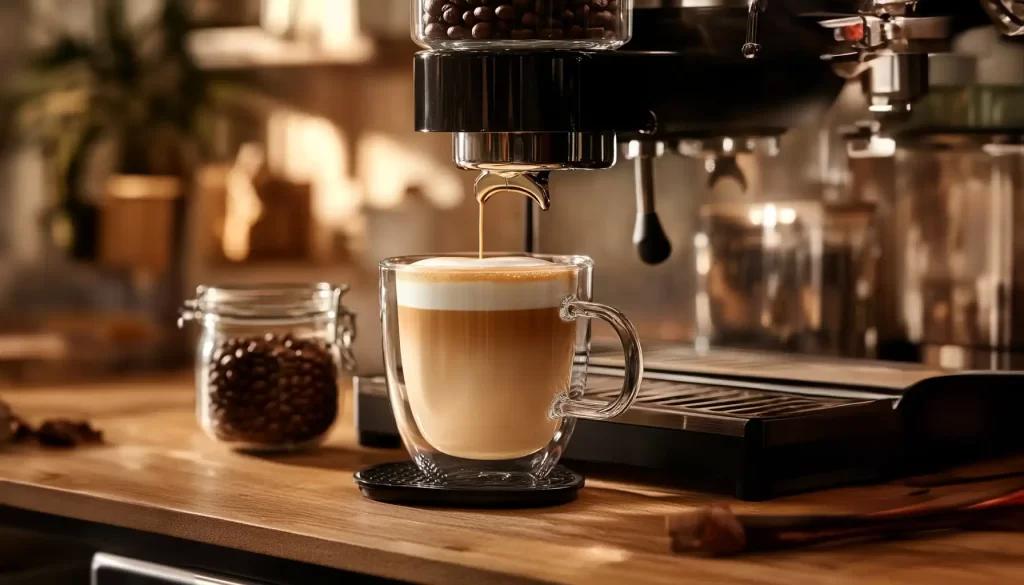When it comes to beloved coffee classics, the debate of cappuccino vs latte is one that excites coffee lovers worldwide. Coffee is more than just a drink; it’s a ritual and a cultural connector, offering moments of relaxation, inspiration, and indulgence.
Both cappuccino and latte start with the same core ingredients—espresso and milk—but their differences in preparation, texture, and flavor have made them distinct favorites across the globe. Whether you prefer the bold and foamy richness of a cappuccino or the creamy, smooth indulgence of a latte, understanding what sets them apart can elevate your coffee experience.

In this guide, we’ll explore everything you need to know about cappuccino vs latte, from their origins and ingredients to how to choose your perfect brew.
What is a Cappuccino?
A cappuccino is one of the most iconic coffee beverages, celebrated for its perfect balance of bold espresso and velvety milk foam. Its distinct preparation and flavor have made it a favorite for coffee enthusiasts around the world, particularly those who enjoy a strong, creamy brew.

The Origin of Cappuccino
The cappuccino has its origins in Italy, where it was named after the Capuchin monks. The drink’s creamy brown hue and foamy top are reminiscent of the monks’ robes and shaved heads. Over time, the cappuccino evolved into a symbol of tradition and balance, becoming a cornerstone of Italian coffee culture. Its popularity soon spread globally, solidifying its status as a coffeehouse staple.
Key Ingredients
- Espresso: Forms the bold and flavorful base of the drink.
- Steamed Milk: Adds smoothness and creaminess to balance the espresso.
- Milk Foam: A thick, airy layer that crowns the cappuccino, providing texture and a touch of sweetness.
How It’s Made
Cappuccinos are meticulously crafted using equal parts espresso, steamed milk, and milk foam. Baristas froth the milk with precision to create a dense, creamy foam that sits atop the drink. The process involves:
- Brewing a rich shot of espresso.
- Steaming milk to achieve a silky consistency.
- Adding an even layer of foam to the top, creating the signature three-layer structure.
Flavor Profile
The cappuccino is known for its bold and robust flavor, thanks to its espresso base. The addition of creamy steamed milk mellows the intensity, while the light, airy foam adds a slightly sweet note. This harmonious blend of flavors makes the cappuccino a satisfying choice for those who enjoy a strong, yet balanced coffee experience.
Whether savored as a morning ritual or paired with a sweet treat, the cappuccino exemplifies the art of coffee craftsmanship. It’s a perfect option for anyone exploring the dynamic world of cappuccino vs latte comparisons.
What is a Latte?
A latte, short for caffè latte, is a creamy and versatile coffee beverage that has become a global favorite. Known for its smooth texture and mild flavor, the latte is a perfect introduction to coffee for those who prefer a gentler brew.

The Origin of Latte
The word latte translates to “milk coffee” in Italian, and the drink is traditionally served as part of a hearty Italian breakfast. While the classic caffè latte was originally enjoyed at home, the modern latte we know today gained global recognition in American coffee shops. Its customizable nature and the artistry of latte art have made it a staple in cafes worldwide.
Key Ingredients
- Espresso: A single or double shot forms the rich base of the drink.
- Steamed Milk: Makes up the bulk of the drink, providing its creamy texture.
- Milk Foam: A thin, velvety layer that adds a finishing touch and serves as a canvas for latte art.
How It’s Made
The latte is crafted by blending a shot of espresso with a generous amount of steamed milk, creating a drink that is both smooth and indulgent. The preparation process involves:
- Brewing a robust shot of espresso.
- Steaming milk to a creamy consistency without over-frothing.
- Pouring the steamed milk over the espresso and topping it with a thin layer of foam.
- Often, the surface is decorated with intricate latte art, such as hearts or rosettes, showcasing the barista’s skill.
Flavor Profile
The latte is celebrated for its creamy, smooth, and mild flavor. With its higher milk content, the drink softens the bitterness of the espresso, making it a comforting choice for those who enjoy a sweeter, less intense coffee. The subtle balance of coffee and milk ensures the latte remains versatile, pairing well with a variety of flavored syrups like vanilla, caramel, or hazelnut.
Whether you’re looking for a warm start to your day or a soothing afternoon treat, the latte offers a delightful experience for coffee enthusiasts and casual drinkers alike. In the timeless debate of cappuccino vs latte, the latte stands out for its creamy indulgence and universal appeal.
Key Differences Between Cappuccino and Latte
While cappuccino and latte share similar ingredients, their differences lie in preparation, texture, and taste. Understanding these distinctions can help you choose the perfect brew for your preferences.
1. Ingredients and Ratios
- Cappuccino: Crafted with equal parts of espresso, steamed milk, and milk foam. This balanced ratio highlights both the coffee’s boldness and the creamy texture.
- Latte: Features a higher proportion of steamed milk and a smaller layer of foam. The result is a milkier and smoother drink, making it ideal for those who enjoy a softer coffee flavor.
2. Texture and Foam
- Cappuccino: Topped with a thick, airy layer of milk foam that creates a light and frothy texture. The foam adds a delightful contrast to the rich espresso beneath.
- Latte: Known for its creamier and velvety consistency, the latte’s thin foam layer enhances its smooth mouthfeel without overpowering the milk’s richness.
3. Serving Size and Presentation
- Cappuccino: Typically served in smaller cups, usually 5–6 ounces, which keeps the flavors concentrated and intense.
- Latte: Presented in larger cups or mugs, ranging from 8–12 ounces, allowing for a greater volume of milk. The larger surface area often showcases intricate latte art, adding a visual treat to your coffee experience.
4. Flavor and Strength
- Cappuccino: Boasts a stronger espresso flavor, as the equal parts of milk and foam complement rather than dilute the coffee’s intensity. It’s a robust and bold choice for espresso lovers.
- Latte: Offers a milder, sweeter taste, with the higher milk content softening the espresso’s bitterness. This makes it an excellent option for those who prefer a gentle and comforting coffee profile.
In the debate of cappuccino vs latte, your choice ultimately comes down to your taste preferences. If you love bold, concentrated flavors, cappuccino is the way to go. For a creamier, mellow experience, the latte will be your ideal companion.

Which One Should You Choose?
Cappuccino vs Latte for Different Palates
- Opt for a cappuccino if you enjoy bold coffee flavors with a balanced creaminess.
- Choose a latte if you prefer a smooth, milk-forward drink with a comforting feel.
Best Times to Enjoy Each Drink
- Cappuccino: Perfect for mornings or as a midday pick-me-up.
- Latte: Great for any time of the day, especially as an afternoon treat.
Dietary Preferences and Customizations
Both drinks can be customized with dairy-free options (almond, oat, soy milk) or flavored syrups like vanilla, caramel, or hazelnut.
How to Make a Cappuccino at Home
Making a cappuccino at home allows you to enjoy this beloved coffee classic with your personal touch. With the right tools and a little practice, you can achieve a café-quality drink that rivals your favorite coffee shop.
Tools and Ingredients You Need
- Espresso Machine: Ideal for authentic espresso, but strong brewed coffee works as a substitute.
- Milk Frother: For creating the dense, creamy foam that defines a cappuccino.
- Freshly Ground Coffee Beans: High-quality beans enhance the flavor and aroma.
- Whole Milk or Plant-Based Alternatives: Choose your preference for a creamy finish.
Step-by-Step Recipe
- Brew the Espresso:
- Use your espresso machine to extract a single shot of espresso.
- If you don’t have an espresso machine, brew a strong coffee concentrate using a French press or stovetop Moka pot.
- Steam and Froth the Milk:
- Heat your milk of choice to around 150°F (65°C), ensuring it doesn’t boil.
- Use a milk frother to create a thick, velvety foam. If you don’t have a frother, whisk the heated milk vigorously or shake it in a sealed jar before pouring.
- Assemble the Cappuccino:
- Pour the steamed milk into the espresso, leaving room for foam.
- Gently spoon the dense foam on top, creating the signature three-layer cappuccino structure.
- Optional Touch:
- Sprinkle cocoa powder or cinnamon on top for added flavor and visual appeal.
Enjoy your homemade cappuccino alongside a biscotti or your favorite pastry for the ultimate coffee break!
How to Make a Latte at Home
Crafting a latte at home is a rewarding way to enjoy this creamy, comforting coffee classic. With just a few tools and ingredients, you can recreate the rich and smooth texture of a café latte right in your kitchen.
Tools and Ingredients You Need
- Espresso Machine: Ideal for pulling a rich shot of espresso. Alternatively, use strong brewed coffee.
- Milk Frother or Saucepan: For heating and lightly frothing milk to achieve a creamy texture.
- Whole Milk or Plant-Based Alternatives: Oat, almond, or soy milk work wonderfully for lattes.
Step-by-Step Recipe
- Brew the Espresso:
- Use your espresso machine to prepare a single or double shot of espresso.
- If you don’t have an espresso machine, brew a concentrated coffee using a French press or Aeropress.
- Steam the Milk:
- Heat your milk of choice in a saucepan over low heat, avoiding boiling.
- Use a milk frother or whisk to lightly aerate the milk, creating a creamy consistency with minimal foam.
- Assemble the Latte:
- Pour the steamed milk into the espresso, leaving a small layer of foam on top.
- Swirl or gently shake the milk as you pour to achieve a smooth blend of coffee and milk.
- Add a Personal Touch:
- Garnish with a sprinkle of cinnamon, cocoa powder, or vanilla syrup for added flavor.
Sip your homemade latte slowly, and pair it with a croissant or muffin for a delightful treat!
Fun Facts About Cappuccino and Latte
Cultural Significance
- Italians typically enjoy cappuccinos only in the morning, never after meals.
- Lattes have become a canvas for latte art, with intricate designs symbolizing creativity in cafes.
Popular Variations Worldwide
- Cappuccino: Iced cappuccino, mocha cappuccino.
- Latte: Chai latte, matcha latte, turmeric latte.
Frequently Asked Questions (FAQs)
1. Which has more caffeine: cappuccino or latte?
Both typically contain the same amount of caffeine per espresso shot.
2. Can I make a cappuccino without an espresso machine?
Yes, you can use a strong brewed coffee and manually froth the milk with a handheld frother.
3. Are lattes healthier than cappuccinos?
It depends on the milk ratio. Lattes contain more milk, which may mean higher calories but also more nutrients.
4. What’s the difference between a flat white and a latte?
A flat white has less milk and foam, creating a richer espresso flavor compared to a latte.
5. Is cappuccino stronger than latte?
Yes, cappuccinos have a bolder taste due to their smaller milk-to-espresso ratio.
Conclusion
Final Thoughts on Cappuccino vs Latte
Cappuccino and latte are more than just coffee drinks—they represent the artistry and diversity of coffee culture. Each has its own distinct appeal: the cappuccino’s bold espresso flavor and airy foam make it ideal for those who enjoy a strong, textured coffee, while the latte’s creamy, smooth profile offers a comforting experience for milk lovers.
Finding Your Perfect Coffee Match
The beauty of these two classics lies in their versatility. Experimenting with both, along with their creative variations, allows you to explore different flavor profiles and styles. Whether you prefer a frothy cappuccino to kick-start your morning or a mellow latte for a mid-afternoon break, there’s no wrong choice. Try both and embrace the rich diversity of coffee culture!
Resources
1. Understanding Coffee Basics
- National Coffee Association: Explore the history and brewing techniques of coffee.
2. Cappuccino and Latte Recipes
- Home Barista Guide – Cappuccino: Learn the art of making a perfect cappuccino.
- Perfect Latte Recipe – AllRecipes: Step-by-step guide to crafting a latte at home.
3. Coffee Gear and Tools
- Whole Latte Love: Find espresso machines, milk frothers, and brewing tools.
4. Coffee Culture and Insights
- CoffeeGeek: Dive into coffee reviews, tips, and brewing insights.
- Barista Magazine Online: Explore trends and stories from the world of coffee professionals.
5. Health and Nutrition Information
Mayo Clinic – Coffee and Health: Understand the nutritional benefits and considerations of coffee consumption.

